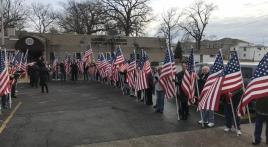The Korean War has often been called the “Forgotten War.” This centennial year of
our participation in WWI recalls another forgotten but nevertheless signature event that
took place at the same time: our invasion of the USSR. It is significant not only because
of our incursion onto Russian soil but also because most of the action took place after the
Nov. 11, 1918, Armistice ended the war with Germany. This is the account of what
has been called the Polar Bear Expedition or, more broadly, the American Expeditionary
Force North Russia. This intervention began in August 1918 and ended in April 1920.
It involved sending American troops to both the western and eastern sides of Russia.
In this decision lay a number of conflicting issues that made the presence in Russia
questionable, and to this day resurrects passions felt in Russia.
After the Bolsheviks took over power from Czarist Russia in 1917 they made a
separate peace agreement with Germany. This effectively took out an attempt by the
Allies to conduct a combat front in the East, thereby weakening the German efforts on the
Western Front. Great Britain and France put pressure on President Wilson to assist in
reinforcing the North Russia campaign. A key objective was to prevent huge stockpiles
of Allied war materials, stored in Archangel on the west and Vladivostok on the eastern
sides of Russia, from falling into the hands of either the Germans or the Bolsheviks.
Under pressure from Great Britain and Russia, President Wilson reluctantly agreed to a
limited participation by American doughboys with an understanding that these troops
would only be used for safeguarding stockpiled war materials. But, as we shall see, that
level of participation never became a reality.
In July 1918 the Army’s 85th Division, comprised mostly of recruits from Michigan
and Wisconsin, having completed training at Camp Custer in Michigan, left for duty on
the Western Front. President Wilson sent a directive to General Pershing to send some
troops to assist the British and French in reinforcing the Eastern Front in Russia.
Pershing prepared new orders for several regiments of the 85th Division to join the
British and French troops in Russia. The American troops would be under direct
control of the British Command.
President Wilson, realizing there were huge supplies of war materials in and near
Vladivostok on the eastern side of Russia, ordered the War Department to arrange for
a deployment of troops to protect the supplies and rail stock in that part of Russia. By
sending troops to the far eastern edge of Russia it was hoped they could prevent a
Czech Legion, that helped the Allied cause, from being destroyed by the increasingly
strong Communist Red Army. Additionally, Japan was building a large presence in
Siberia, and that was of concern for political and business reasons. The US did not
want to get involved with the civic and military infighting that was going on with
various Russian combatants. These included the Bolsheviks, Cossack guerrilla bands
and White Russians. This made the military mission for the American Expeditionary
Force and its commander, General William Graves, in the East an extremely vague
one. To quote the memo General Graves received from Secretary of War Newton
Baker, …”the policy of the United States in Russia which you are to follow is watch
your step, you will be walking on eggs with dynamite.”
What followed at both the western and eastern sides of Russia was, for the US,
anything but a guarding of supplies or safeguarding the Trans-Siberian Railway. In the
west the Bolsheviks were confronted by the Allies who were trying to assist the Czech
Legion that had been fighting the Germans but were facing annihilation by the Red
Army. Under British leadership about 5,000 US men, mostly members of the 339th
Infantry Regiment from Michigan and Wisconsin, found themselves in battle along a
haphazard disjointed front of several hundred miles. The US was embroiled in a civic
struggle among the Bolsheviks, various Cossack groups and the White Russian forces,
the latter trying to defeat the Bolsheviks. It was an impossible situation, a military
quagmire. Coupled with the severe cold, at times reaching -60F, the results were
casualties due to military action, frostbite, accidents and illness including cases of
the Spanish flu.
Meanwhile, on the eastern side of Russia, in the vicinity of Vladivostok, about 8,000
American soldiers, mostly recruits from Camp Fremont, California, and a couple of
regiments from the Philippines, took up duty by mid-August 1918 under the command of
General Graves. As in the western part of Russia, their mission was to guard the
immense amount of supplies, including hundreds of American train engines and cars.
Germany by now was near collapse. The mission of guarding supplies was to
maintain a neutral position and keep the Trans-Siberian Railway open. The infighting
that was occurring among the Cossacks, the White Russians and the Bolsheviks made it
impossible for the American troops to stay neutral. In trying to guard and maintain
certain sectors of the rail lines, they were under attack from one faction or another. Also,
there was concern that the Japanese were gaining influence over that part of the East,
something America did not want.
With an ill-defined mission and the harsh conditions in Russia, troop morale was low;
instances of small mutinies occurred within the ranks. Members of Congress called for
an immediate recall of the troops. American families also petitioned Congress to put an
end to the no-win position of the US. By April, 1919 General Pershing ordered complete
withdrawal. This was accomplished immediately in the western part of Russia, but it
would not be completed in the eastern section until April 20, 1920.
When the withdrawal was completed, over 400 Americans had lost their lives during this
occupation, This included approximately 127 killed in combat and from battle-related
injuries, illness, accidents and disease. Those who lived through that post-Armistice
never forgot that little-known piece of American military history. To this day, Russia has
reminded us of the incursion of America onto Russian soil. On the centennial of this
action, may we pay tribute to those Americans who served and sacrificed during this other
“Forgotten War” when the rest of the world was celebrating the end of WWI



